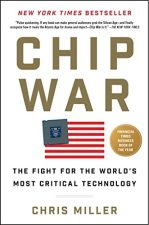“Chip War”
by Chris Miller
430 pp., 2022, $30.00, Scribner
 In our business, you might think the “Chip War” is about the battle between megalith GPI and upstarts like CHIPCO, US Playing Cards, ASM, and Blue Chip. They all manufacture the chips and plaques that are used on blackjack, roulette and craps tables around the world.
In our business, you might think the “Chip War” is about the battle between megalith GPI and upstarts like CHIPCO, US Playing Cards, ASM, and Blue Chip. They all manufacture the chips and plaques that are used on blackjack, roulette and craps tables around the world.
While these currency substitutes are important, it is integrated circuits or “chips” that are far more valuable to our industry. Without these devices formed on wafers of silicon, not a single slot machine today would function, our shufflers wouldn’t shuffle, and keycards would not open hotel room doors. That’s not including the fact that our water, electricity, heating and cooling systems would all shut down. And can you imagine life without a coffee maker, fridge, or microwave in the break room?
Your grandparents’ casino of the 1940s and 50s could have functioned just fine, but not one of today’s operations could even turn on the lights. Our industry has become completely dependent on “chips”.
This monumental work from Chris Miller, which is subtitled “The Fight for the World’s Most Critical Technology,” isn’t much concerned about casino profits. Instead, Miller explains that our entire culture and economy, not to mention our nation’s security, are all at stake and tied inseparably to the fate of the chip industry. If you give it some quick thought, you too surely realize that in this day of the internet of things, our entire lifestyle is dependent on chips.
With that realization, how much do you really know about how we got here, who developed this technology and who will control what lies ahead? The Financial Times named this work the “Business Book of the Year” and it was a New York Times bestseller.
In some ways, this reads like the rise and fall and rise again of an ancient civilization. But it all takes place in the chip-accelerated span of just 60 years. This book details the development of this industry that has changed nearly every aspect of our lives. And Miller explains the importance, and future, of Moore’s law: “the number of transistors in an integrated circuit (IC) doubles about every two years.” It all started with just four transistors in 1961. Today we’re talking consumer chips available with 114 billion switches on a surface smaller than a postage stamp.
Not everyone has heard of Jack Kilby, Robert Noyce, Gordon Moore and Andy Grove. I’ve been an amateur computer geek for years, so these men were vaguely familiar. But Miller’s narrative is an easy read and provides a thorough background how these four pioneers and many others transformed our world so quickly (it was Gordon Moore who prophesied the “Law”).
You’ll learn the origin stories of legendary companies like Texas Instruments, Fairchild, Intel, TSMC, Samsung, AMD, Qualcomm, Nvidia and how Silicon Valley became silicon valley.
It is the use of chips in defense applications that is a recurring theme from the beginning to the end of this book. Nothing illustrates that better than the effort Americans made to destroy the Thanh Hoa Bridge in North Vietnam starting in 1965. The U.S. had dropped hundreds of bombs on the target without bringing down the structure. However, on May 13, 1972, we dropped just 24 bombs on the target. All hit and destroyed it. The difference was our first “smart” bombs. They were guided to the target by using embedded computer chips moving their fins. It was to change warfare.
But you’ll also learn that we went from a leader in defense superiority then to struggling to keep up to China today. And that the entire globe is critically dependent on Taiwan for most of the key components.
That evolution continues until today as Miller describes tomorrow’s weapons like AI-controlled, unmanned windsurfers and missiles that find their own targets. It doesn’t take much of a stretch to envision a bit of a “Terminator” future.
You’ll also learn how obscure fields like “lithography” and the related quest to make light beams smaller and smaller played such an important role in fabricating today’s chips.
Even our gaming industry, which has never been a leader in cutting-edge technology, is beginning to see the benefits of this chip evolution. Cloud-based applications, artificial intelligence analytics, and new database methodologies are all showing promising results for increasing profitability. It’s all because some extremely talented individuals managed to stuff more and more transistors on to a chip.
It is almost embarrassing that I knew so little about the details of this “war” before now. As I sit at my desk writing this, I notice the impending deadline on my Apple watch is approaching. I watch these letters appearing on the LCD screen of my monitor as I type, listen to background music from Spotify, and munch on some microwave popcorn. As I get ready to hit “Send” to route this review off to my editor, I realize that just about the only thing I could have done today without “chips” was to read this book. You should too.
The hardcover is in stores and online for $25 to 30.



